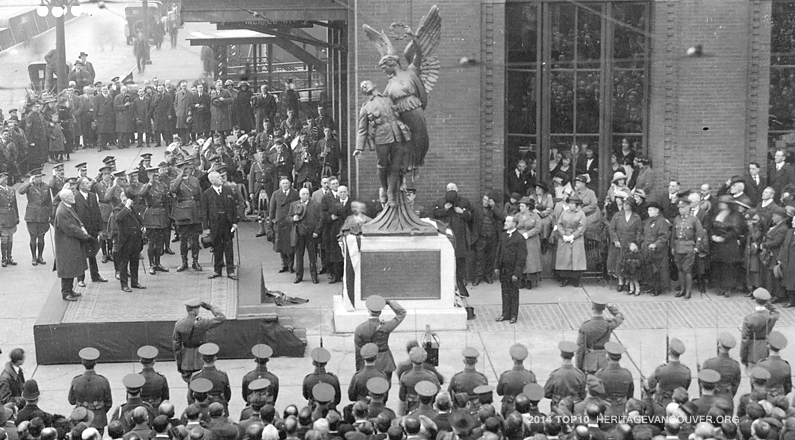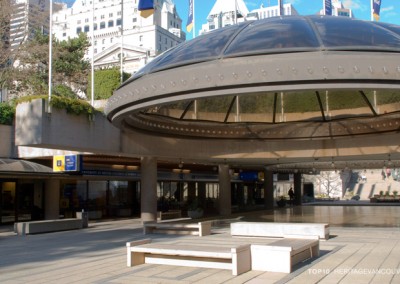The City has no plan or budget for the maintenance, repair, restoration, or long term conservation of historic monuments.
Threat
What is the threat to our Historic Monuments?
Most of the historic monuments and public artworks listed on the Heritage Register are under the direct control of the City of Vancouver. However, the City has no plan in place for their maintenance, repair or restoration, nor is there any identified budget or management plan for their long term conservation.
Some of these monuments are significantly threatened by serious neglect, and many are targets for vandalism, graffiti and metal thieves. The recent high value of scrap metal has meant that thieves sometimes target statues and plaques; the bronze plaques commemorating the Georgia Viaduct have been stolen, and the recent theft of a statue from Queen Elizabeth Park – since recovered – illustrate this problem.
Just as significant is the threat from improper cleaning and maintenance. In 1967, wire brushes and detergent were used to scrub the “dirt” off the Angel of Victory. It was, in fact, the usual patina of a bronze statue exposed to the elements, but scratch marks from the cleaning can still be seen on the statue. More recently, abrasive cleaning techniques were used on the Captain Vancouver Statue at City Hall. These ill-considered cleaning techniques will destroy the integrity of these monuments over time.
Without a proper maintenance plan, and financial resources to implement it, our monuments will continue to deteriorate, and even disappear.
Significance
Why are our Historic Monuments significant?
Vancouver has a rich legacy of commemorative monuments, memorials and markers that celebrate historic events and significant people. These are some of our finest public artworks, and add immeasurably to our urban streetscape and parks. Bronze statues, plaques and great public embellishments, such as the Lions on the Lions Gate Bridge and the Angel of Victory in front of Waterfront Station, are irreplaceable pieces of public art and intrinsic Vancouver landmarks. These are also major examples of the work of some of our greatest artists, such as Charles Marega.
Position
Heritage Vancouver’s Position
Our precious legacy of historic monuments should be protected, maintained and restored. We must begin to think about how these unique and irreplaceable historic resources will be protected in the long-term.
Heritage Vancouver encourages the City of Vancouver to immediately undertake a management plan for the historic monuments under its direct custody. A special restoration fund should be established, and further cost-sharing opportunities and community partnerships should be explored. Proper heritage conservation techniques should be used for all historic monuments.
Illustrated: Angel of Victory
This 3,000 pound, seven foot tall, bronze statue depicts a female angel and fallen soldier ascending to heaven. The Angel of Victory is part of the first wave of Canadian war memorials that followed the end of the Great War. As soldiers who died overseas were buried where they fell, memorials were erected in communities across the country as a public remembrance. In 1921, CPR commissioned Montreal sculptor Coeur de Lion McCarthy to create this statue, copies of which stand at CPR stations in Vancouver, Winnipeg and Montreal. The Angel is a moving reminder of Canada’s wartime sacrifices.


![1. Pantages Theatre (1907) [lost]](http://heritagevancouver.org/wp-content/uploads/2016/05/t10-pantages-A-795-400x284.jpg)



![5. Heatley Block (1931); Houses (1889 & 1898) [saved]](http://heritagevancouver.org/wp-content/uploads/2008/02/HVS-top10-heatley-400x284.jpg)
![7. Firehall No. 15 (1913) [saved]](http://heritagevancouver.org/wp-content/uploads/2001/06/firehall-No-15-400x284.jpg)


![10. Hollow Tree (Stanley Park) [saved]](http://heritagevancouver.org/wp-content/uploads/2009/02/t10-hollow-tree-795-400x284.jpg)